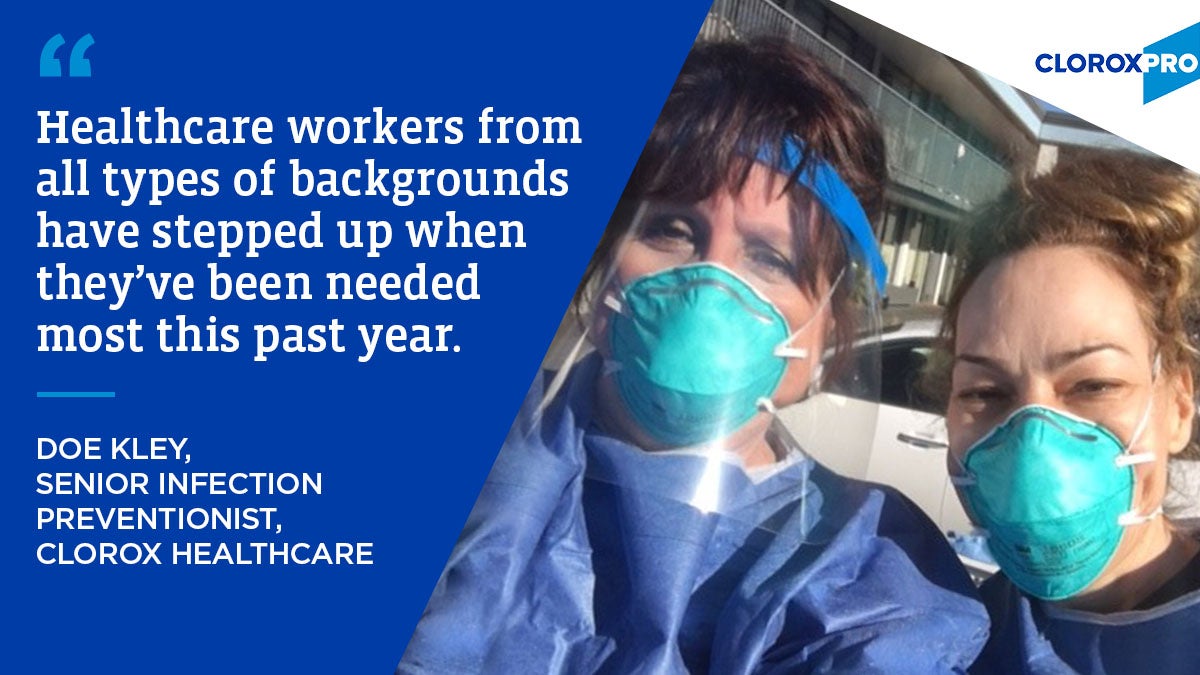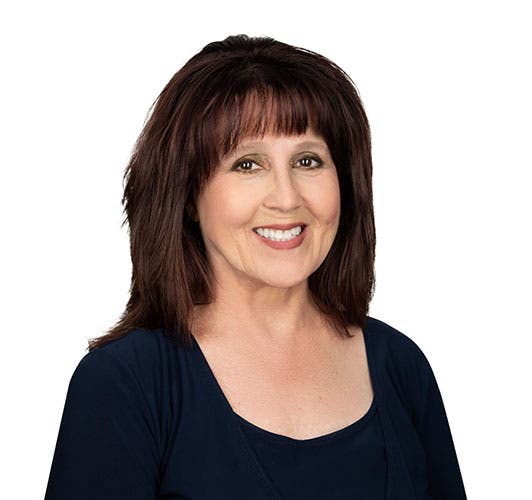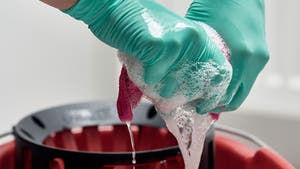A Little About Me
I have been a nurse since 1993 and have worked as an Infection Preventionist (IP) for the past 20 years. Throughout my infection control career, I’ve faced challenges such as the potential weaponizing of smallpox after 9/11, the SARS outbreak in 2003, the H1N1 pandemic in 2009, and the Ebola outbreak in 2014 (just to name a few). I have seen a lot of tragedy and hardship, most of which I never would have dreamed of seeing in a million years.
In 2018, I made a big change in my infection control path. I was afforded an opportunity to join the Clorox Healthcare team as a Senior Infection Preventionist. After completing my first year in my new role, the COVID-19 pandemic was just beginning – a monumental pandemic that we will likely never see again in our lifetimes. In a matter of a few months, COVID-19 spread like wildfire to nearly every continent. We spent most of 2020 in lockdown, and infection prevention became more relevant than ever.
My COVID-19 Pandemic Story

In March of 2020, as part of the emergency response to COVID-19, California Governor Gavin Newsom released an executive order allowing the state of California to commandeer hotels and medical facilities to treat COVID-19 patients. This was termed “Project Roomkey” 2 and local counties were tasked with manning these shelters.1
In my local county, some of these hotels are being used as temporary isolation housing for unsheltered residents. The intent is to reduce transmission in the community from infected persons who are experiencing homelessness or live in congregate or over-crowded settings (e.g., prisons, etc.). Meanwhile, some of the hotels (named Safer Ground sites) are designated for medically fragile persons who meet the above criteria and have not been diagnosed with COVID.2
The other hotels (named Operation Comfort sites) serve as shelters to quarantine or isolate COVID-positive or COVID-exposed individuals who meet the criteria listed above. Project Roomkey takes referrals from hospitals, clinics, prisons, emergency shelters, and homeless outreach teams.
Last summer, I learned through a friend that our local county public health department was looking for nurses to replace the public health nurses at the shelters, who were desperately needed by the county to return to their usual public health roles. With a full-blown pandemic underfoot, I had been chomping at the bit to be able to put my IP skills to work and contribute in a substantive way. I was hired part-time to supervise nurses at the COVID-positive shelters. Since July 2020, I have been working every other weekend with medically fragile COVID-positive individuals in the hotels in an underserved area of East Oakland, California.
Challenges from the Front Lines
Since an “isolation/quarantine” hotel had never been created or utilized in modern times, we’ve had to continuously learn and adapt to new situations. This often means that our protocols, along with the CDC guidance for COVID-19, is also continuously evolving. Furthermore, as is often the case in public health nursing, we are with faced limited resources. This includes things as simple as having a consistent supply of environmental surface disinfectants. Just about every time I report for duty, we have a different disinfectant which means having to learn the instructions for use, including the contact time. Also, with the supply chain shortages, it means we have to remember to save our empty bottles and trigger sprays for refilling.
As if fighting COVID-19 were not enough, we’ve also had to address the complicated health and social issues our patients face on a daily basis outside of the pandemic, such as mental health and/or substance abuse disorders. My fellow nurses and I must simultaneously monitor our patients’ COVID symptoms as well as any withdrawal or suicidal ideation indicators. Some of our patients also have complex health issues (e.g., diabetes) so we work diligently to coordinate the appropriate care.
Additionally, patients at Project Roomkey come from all types of socioeconomic backgrounds. For low-income community members, having to quarantine for 14 days or stay isolated at a hotel could mean missing a paycheck or risking the next meal for their family. Meeting these patients’ social or other medical needs is not easy when your patient also has an infectious disease like COVID-19. I quickly realized that it’s not the same as working in the hospital outside the pandemic where virtually every resource you need to do your job is on-hand.
In addition to our patients, our nursing staff also come from a variety of backgrounds, which range from new graduates to veteran caregivers. Clinical backgrounds include hospital (ICU, OR, and Medical-Surgical), long-term care, home care, infection prevention and control, behavioral health, public health, and even nurses from academia. What I appreciated this past year was that no one used their specialty to appear superior to anyone else. We simply leaned on each other’s strengths and got the work done.
Finding Inspiration Among the Hardship
Since this work takes place in addition to my regular “day job” with Clorox Healthcare, I’ve had to find inspiration to keep showing up every other weekend. Fortunately, this did not prove to be too difficult as I’ve found great inspiration in both my patients and my coworkers. The most vulnerable in our community needed us during this historic event and as a nurse, I felt that it was my duty to help.
Like me, many of my fellow hotel coworkers took on this work in addition to their “day jobs.” Their dedication motivates me to keep showing up week after week. These amazing individuals not only give their time and skills, but they often donate items to these families in need – things like winter clothing, children’s toys, and games to keep them occupied during quarantine. In addition to nurses, the healthcare team includes nurse practitioners, physicians, mental health providers, substance abuse providers, and pharmacists. Meanwhile, we couldn’t do any of this without the relentless work of the facilities team, housing support staff, housekeepers, cooks and security guards in the hotels. The team collaboration and the comradery of this group has been truly something amazing to be a part of.
Finally, I would be remiss if I didn’t recognize the inspiration provided by all of my fellow IPs out there wherever they have been working during this pandemic. Your dedication to our profession is nothing short of remarkable.
Relief is in Sight
When both the Moderna and Pfizer vaccines were granted Emergency Use Authorization (EUA) from the Federal Drug Administration in December 2020, I was beyond elated to help run the staff vaccination clinic.3 Along with a few of my coworkers, we administered nearly 140 first doses to our fellow shelter workers, which included nurses, medical assistants, housing support staff, housekeepers, cooks, and security guards. I was more than happy to do it all over again four weeks later, too. Being able to offer hope through a vaccine has brought me such joy that I have volunteered to administer vaccinations to the general public as well.
As public health officials, healthcare workers, and members of our community continue to come together to help fight the spread of COVID-19, I’m grateful for the resilience I’ve witnessed first-hand over the past year. This virus is not done with us yet and we are not done fighting, but I have hope for the future. Before the pandemic struck, 2020 had been designated the International Year of the Nurse in honor of the 200th anniversary of Florence Nightingale’s birthday.4 While this may have been lost in the chaos of the pandemic, we nurses will never forget the additional meaning behind this past year.
For the latest information on COVID-19 and variants, visit our CloroxPro COVID-19 Hub.
References
- Alameda County Public Health Care for the Homeless. Isolation Housing for COVID-19 [nternet]. [cited 2021 Mar 7]. Available from: https://www.achch.org/isolation-housing.html
- Office of the Governor Gavin Newsom. Governor Newsom Issues New Executive Order Further Enhancing State and local Government’s Ability to Respond to COVID-19 Pandemic [internet]. [cited 2021 Mar 7]. Available from: https://www.gov.ca.gov/2020/03/12/governor-newsom-issues-new-executive-order-further-enhancing-state-and-local-governments-ability-to-respond-to-covid-19-pandemic/
- Federal U.S. Food & Drug Administration. COVID-19 Vaccines [internet]. [cited 2021 Mar 7]. Available from: https://www.fda.gov/emergency-preparedness-and-response/coronavirus-disease-2019-covid-19/covid-19-vaccines
- World Health Organization. Executive Board Designates 2020 as the “Year of the Nurse and midwide.” [internet]. [cited 2021 Mar 7]. Available from: https://www.who.int/news/item/30-01-2019-executive-board-designates-2020-as-the-year-of-the-nurse-and-midwife-


